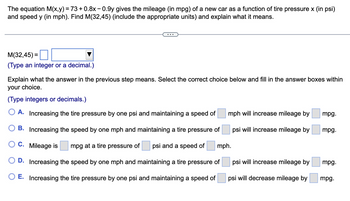
Calculus: Early Transcendentals
8th Edition
ISBN: 9781285741550
Author: James Stewart
Publisher: Cengage Learning
expand_more
expand_more
format_list_bulleted
Question

Transcribed Image Text:The equation M(x,y) = 73 +0.8x -0.9y gives the mileage (in mpg) of a new car as a function of tire pressure x (in psi)
and speed y (in mph). Find M(32,45) (include the appropriate units) and explain what it means.
M(32,45)=
(Type an integer or a decimal.)
Explain what the answer in the previous step means. Select the correct choice below and fill in the answer boxes within
your choice.
(Type integers or decimals.)
A. Increasing the tire pressure by one psi and maintaining a speed of
B. Increasing the speed by one mph and maintaining a tire pressure of
C. Mileage is
mpg at a tire pressure of psi and a speed of mph.
D. Increasing the speed by one mph and maintaining a tire pressure of
O E. Increasing the tire pressure by one psi and maintaining a speed of
mph will increase mileage by
psi will increase mileage by
psi will increase mileage by
psi will decrease mileage by
mpg.
mpg.
mpg.
mpg.
Expert Solution
This question has been solved!
Explore an expertly crafted, step-by-step solution for a thorough understanding of key concepts.
Step by stepSolved in 3 steps with 3 images

Knowledge Booster
Similar questions
- If y = 12 when x = 6/7, find x when y = 16arrow_forwardDetermine the value of the constant k, such that 8 4 Sdx = 1.90038. 2x-1 k Give your answer correct to 3 decimal place. k=arrow_forwardFind the reference number for each value of t. 137T (a) t= 107T (b) t = - 7 (c) t = 6 Is (d) t= -7arrow_forward
- The following equation represents the relationship between hours of TV watched per day (x) and the number of situps a person can do (ŷ).ŷ = -0.956xx + 34.573Use this model to predict the number of situps a person who watches 8 hours of TV can do. (to 2 decimal places)arrow_forwardThe following equation represents the relationship between hours of TV watched per day (x) and the number of situps a person can do (ŷ).ŷ = -0.895xx + 32.409Use this model to predict the number of situps a person who watches 2.5 hours of TV can do. (to 2 decimal places)arrow_forwardVx- 3=1 %3Darrow_forward
arrow_back_ios
arrow_forward_ios
Recommended textbooks for you
 Calculus: Early TranscendentalsCalculusISBN:9781285741550Author:James StewartPublisher:Cengage Learning
Calculus: Early TranscendentalsCalculusISBN:9781285741550Author:James StewartPublisher:Cengage Learning Thomas' Calculus (14th Edition)CalculusISBN:9780134438986Author:Joel R. Hass, Christopher E. Heil, Maurice D. WeirPublisher:PEARSON
Thomas' Calculus (14th Edition)CalculusISBN:9780134438986Author:Joel R. Hass, Christopher E. Heil, Maurice D. WeirPublisher:PEARSON Calculus: Early Transcendentals (3rd Edition)CalculusISBN:9780134763644Author:William L. Briggs, Lyle Cochran, Bernard Gillett, Eric SchulzPublisher:PEARSON
Calculus: Early Transcendentals (3rd Edition)CalculusISBN:9780134763644Author:William L. Briggs, Lyle Cochran, Bernard Gillett, Eric SchulzPublisher:PEARSON Calculus: Early TranscendentalsCalculusISBN:9781319050740Author:Jon Rogawski, Colin Adams, Robert FranzosaPublisher:W. H. Freeman
Calculus: Early TranscendentalsCalculusISBN:9781319050740Author:Jon Rogawski, Colin Adams, Robert FranzosaPublisher:W. H. Freeman
 Calculus: Early Transcendental FunctionsCalculusISBN:9781337552516Author:Ron Larson, Bruce H. EdwardsPublisher:Cengage Learning
Calculus: Early Transcendental FunctionsCalculusISBN:9781337552516Author:Ron Larson, Bruce H. EdwardsPublisher:Cengage Learning

Calculus: Early Transcendentals
Calculus
ISBN:9781285741550
Author:James Stewart
Publisher:Cengage Learning

Thomas' Calculus (14th Edition)
Calculus
ISBN:9780134438986
Author:Joel R. Hass, Christopher E. Heil, Maurice D. Weir
Publisher:PEARSON

Calculus: Early Transcendentals (3rd Edition)
Calculus
ISBN:9780134763644
Author:William L. Briggs, Lyle Cochran, Bernard Gillett, Eric Schulz
Publisher:PEARSON

Calculus: Early Transcendentals
Calculus
ISBN:9781319050740
Author:Jon Rogawski, Colin Adams, Robert Franzosa
Publisher:W. H. Freeman


Calculus: Early Transcendental Functions
Calculus
ISBN:9781337552516
Author:Ron Larson, Bruce H. Edwards
Publisher:Cengage Learning